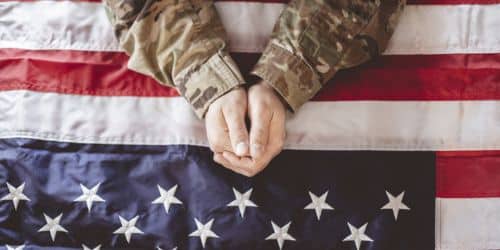The Department of Veterans Affairs (VA) provides veterans with service-connected disabilities with veterans’ life insurance (VALife), which is a valuable benefit. If you are a veteran with a service-connected disability, I encourage you to learn more about VALife. It may be the right life insurance option for you and your loved ones.
In this blog post, we will cover everything you need to know about VALife. We will also provide tips for veterans considering VALife and answer some of the most common questions about VALife. Whether you are just starting to learn about VALife or you are ready to apply, this blog post is the perfect resource for you. Read on to learn everything you need to know about veterans’ life insurance.
Veterans Life Insurance
Veterans life insurance is a life insurance policy specifically designed for veterans of the military. The U.S. Department of Veterans Affairs (VA) frequently offers these policies as a part of the VA’s insurance program. VGLI is a VA program that allows veterans to convert their Servicemembers’ Group Life Insurance (SGLI) coverage to civilian life insurance after service. It offers lifetime renewable term coverage, a conversion option, and death benefits based on the veteran’s SGLI coverage.
These options include:
#1. Servicemembers’ Group Life Insurance (SGLI)
SGLI offers low-cost term life insurance to active duty service members, the National Guard and Reserves, and the Commissioned Corps of NOAA and PHS. Members are automatically enrolled, providing coverage up to $400,000. However, coverage ends after retirement or service separation.
#2. Veterans’ Group Life Insurance (VGLI)
VGLI is a life insurance program that allows veterans to convert their full-time SGLI coverage to lifetime renewable term insurance after separation from service. It provides coverage up to the amount of SGLI the veteran had in force at the time of separation.
#3. Veterans’ Mortgage Life Insurance (VMLI)
VMLI provides mortgage life insurance protection to disabled veterans who have been approved for a VA Specially Adapted Housing (SAH) grant. It is available to veterans who received an SAH grant, have title to the home, and have a mortgage on the home.
#4. Veterans Affairs Life Insurance (VALife)
VALife provides low-cost coverage to veterans with service-connected disabilities. Eligibility for VALife depends on factors such as age and disability rating. It offers whole-life coverage of up to $40,000, with lesser amounts available in increments of $10,000. The elected coverage takes effect two years after enrollment, as long as premiums are paid during the two years
#5. Service-Disabled Veterans Insurance (S-DVI)
S-DVI provides life insurance coverage to veterans who have been given a VA rating for a new service-connected disability in the last two years. It offers guaranteed acceptance of whole-life coverage of up to $40,000, with lesser amounts available in increments of $10,000.
Veterans’ Life Insurance Group
The Department of Veterans Affairs (VA) provides Veterans’ Group Life Insurance (VGLI), a life insurance program that enables veterans to convert their Servicemembers’ Group (SGLI) coverage to a civilian program of lifetime renewable term coverage after separation from service.
Features
#1. Eligibility for VGLI
To qualify for VGLI, veterans must meet two criteria: have part-time SGLI as a member of the National Guard or Reserve, have suffered an injury or disability that disqualified them for standard premium insurance rates, or have SGLI while in the military and be within one year and 120 days of being released from an active-duty period of 31 or more days.
#2. Lifetime Renewable Term Coverage
VGLI offers lifetime renewable term coverage, which means veterans can keep their coverage as long as they continue to pay the premiums.
#3. Conversion Option
VGLI allows veterans to convert their SGLI coverage to VGLI within a specified time frame after separation from service. This provides veterans with the opportunity to continue their life insurance coverage without the need for a medical examination or providing evidence of good health.
#4. Death Benefits
VGLI provides death benefits to the designated beneficiaries upon the death of the insured veteran. The amount of coverage is based on the amount of SGLI the veteran had at the time of separation.
#5. No Cash Value
VGLI is a term life insurance program that provides death benefits only. No cash value component builds over time.
#6. Flexibility in Coverage Amount
Veterans have the flexibility to choose the amount of coverage they want under VGLI, up to the maximum amount available based on their SGLI coverage at the time of separation.
#7. Portability
VGLI is portable, meaning veterans can maintain their coverage even if they change jobs or leave the military. This provides veterans with continued life insurance protection regardless of their employment status.
#8. No War or Terrorism Exclusions
VGLI coverage does not exclude death resulting from war or acts of terrorism. This provides veterans with peace of mind knowing that their coverage remains in effect regardless of the circumstances of their death.
VGLI premiums can be paid through convenient methods such as automatic bank deductions or credit card payments. This makes it easier for veterans to manage their premium payments.
#10. Coverage for Spouses and Children
VGLI also offers the option to add coverage for spouses and dependent children. This allows veterans to extend life insurance protection to their family members, ensuring their financial security in the event of the veteran’s death.
Disabled Veterans Life Insurance
Service-Disabled Veterans Life Insurance (S-DVI) is a life insurance program specifically designed for veterans who have received a service-connected disability rating from the Department of Veterans Affairs (VA). However, as of December 31, 2022, S-DVI stopped accepting new applications, instead, a new program called Veterans Affairs Life Insurance (VALife) was introduced on January 1, 2023, to provide low-cost coverage to veterans with service-connected disabilities
Features of VA Life
#1. Eligibility
Veterans aged 80 or younger with a VA service-connected disability rating, even if the rating is 0%, are eligible for VALife. There is no time limit to apply after receiving the disability rating. Veterans aged 81 or older may also be eligible if they applied for VA disability compensation before turning 81 and received a service-connected disability rating after turning 81, as long as they apply for VALife within two years of receiving the rating.
#2. No Medical Requirements
VALife does not require veterans to meet any health requirements to obtain coverage. This means that veterans can secure life insurance coverage without undergoing a medical examination or answering health-related questions.
#3. Coverage Amount
VALife offers coverage up to $40,000, available in $10,000 increments The coverage amount can be chosen based on the individual needs and preferences of the veteran.
The premium rates for VALife vary based on factors such as the age of the veteran, the coverage amount, the coverage plan chosen, and the frequency of premium payments (monthly or yearly). It’s best to review the premium rates for VALife plans to understand the cost associated with the desired coverage.
#5. Cash Value
VALife policies have a cash value that builds over time after the first two years of enrollment. This means that the policy accumulates value, which can be accessed or borrowed against if needed.
#6. Guaranteed Acceptance
VALife is a guaranteed acceptance whole life insurance program. This means that if you meet the eligibility requirements, your application will be automatically approved without having to prove your health status.
#7. Beneficiary Updates
You can update your beneficiary by completing VA Form 29-336, Designation of Beneficiary Government Life Insurance. There is a secure document upload portal available for submitting the form.
#8. Claim Payout
If you pass away within the two-year waiting period, the beneficiary will receive all the premiums paid plus interest. After the waiting period, the full coverage amount will be paid out as a claim.
Best Veterans Life Insurance
The best VA life insurance is tailored to their individual needs and preferences. Here are our top recommendations:
#1. Prudential Veterans’ Group Life Insurance (VGLI)
Prudential’s VGLI program enables veterans to keep their life insurance coverage after they leave the military. It provides coverage up to the amount of SGLI (Servicemembers’ Group Life Insurance) they had while in service. VGLI is often considered a good option for disabled veterans.
#2. United Services Automobile Association (USAA)
USAA is a well-known insurance provider that offers a range of insurance products, including life insurance. They have specific policies and benefits tailored to meet the needs of veterans and their families. USAA is often recognized for its excellent customer service and competitive rates.
#3. American Armed Forces Mutual Aid Association (AAFMAA)
AAFMAA is a non-profit, member-owned association that provides life insurance and financial solutions to military members and their families. They offer a variety of life insurance options, including whole-life policies, and are known for their commitment to serving the military community, particularly senior veterans.
#4. Uniformed Services Benefit Association (USBA)
USBA is another organization that specializes in providing life insurance coverage to military members and their families. They offer a range of policies, including coverage options for families. USBA is often recognized for its competitive rates and flexible coverage options.
#5. New York Life
New York Life is a reputable insurance company that offers life insurance policies to veterans. They provide a variety of coverage options and have a strong financial stability rating. New York Life is often considered a good option for veterans who are relatively young and healthy.
#6. Aflac
Aflac offers life insurance options specifically designed to meet the needs of veterans. They provide a range of coverage options to ensure veterans and their loved ones are protected financially.
#7. USBA (United States Beneficiary Association)
USBA is a non-profit organization that offers a variety of life insurance options for veterans and their families. They provide both term and whole life insurance policies, with coverage amounts up to $1 million. USBA is known for its competitive rates and flexible coverage options.
Navy Mutual is a mutual benefit association that focuses on providing life insurance coverage for members of the military, veterans, and their families. They offer term, whole, and universal life insurance policies with benefits ranging from $50,000 to $1 million. Navy Mutual is highly regarded for its commitment to serving the military community and providing personalized service.
#9. Armed Forces Benefit Association (AFBA)
AFBA is a non-profit organization that offers life insurance options for active duty, retired military, and veterans. They provide term life insurance policies with coverage amounts up to $500,000, as well as additional benefits such as accidental death and dismemberment coverage. AFBA is known for its competitive rates and excellent customer service.
#10. TruStage Military Life Insurance
TruStage offers life insurance options specifically designed for military members and veterans. They provide term life insurance policies with coverage amounts up to $250,000. TruStage is known for its simplified application process and competitive rates.
Veterans Life Insurance Death Benefits
Veterans life insurance provides death benefits to veterans, service members, and their families. These programs offer coverage amounts up to $400,000 and provide a lump-sum payment to designated beneficiaries upon the insured’s death.
The Perks of Veterans’ Life Insurance Death Benefits
#1. Tax-Free Death Benefit
One of the significant advantages of veterans’ life insurance death benefits is that the death benefit paid to the beneficiary is generally tax-free. This means that the full amount of the benefit goes directly to the designated recipient without being subject to federal income tax.
Veterans’ life insurance death benefits often provide coverage for service-related disabilities. In the case of veterans who have suffered a disability due to their military service, the policy may include provisions for an additional benefit or payout to compensate for the disability.
Veterans’ life insurance death benefits can offer cost-effective premiums compared to private life insurance policies. This is because these programs are typically subsidized by the government, making them more affordable for veterans and their families.
#4. Coverage for Active Duty and Reservists
Some veterans’ life insurance programs provide coverage not only for veterans but also for active duty personnel and members of the Reserves or National Guard. This ensures that individuals currently serving in the military have access to life insurance protection for their loved ones.
#5. Assistance with Funeral Expenses
In addition to the death benefit, veterans’ life insurance programs may assist with funeral expenses. This can help alleviate the financial burden on surviving family members during a difficult time.
#6. Support for Surviving Spouses and Dependents
Veterans’ life insurance death benefits are specifically designed to provide financial support to surviving spouses and dependents. These benefits can help cover ongoing living expenses, education costs, and other financial needs that arise after the loss of a veteran.
#7. Flexibility in Payout Options
Veterans’ life insurance death benefits often provide flexibility in terms of how the funds are paid out. Beneficiaries may have the option to receive a lump sum payment or choose a structured payout plan, such as regular installments over a specified period. This flexibility allows beneficiaries to manage funds according to their individual needs.
#8. Portability
Veterans’ life insurance death benefits are often portable, meaning that they can be maintained even if the veteran changes jobs or leaves the military. This can provide peace of mind to veterans, knowing that their life insurance coverage can continue regardless of their employment status.
#9. Accidental Death and Dismemberment (AD&D) Coverage
Some veterans’ life insurance programs, such as Servicemembers’ Group Life Insurance (SGLI), also provide Accidental Death and Dismemberment (AD&D) coverage. AD&D coverage offers additional financial protection in the event of accidental death or severe injury resulting in dismemberment.
#10. Additional Riders and Benefits
Some veterans’ life insurance programs offer optional riders and benefits that can be added to the policy for an additional cost. These riders may include features such as accelerated death benefits, which allow the insured to access a portion of the death benefit while still alive in the case of a terminal illness.
Who Is Eligible For VA Life Insurance?
The eligibility criteria for veterans’ life insurance programs vary depending on the specific program, such as Servicemembers’ Group Life Insurance (SGLI), Veterans’ Group Life Insurance (VGLI), Family Servicemembers’ Group Life Insurance (FSGLI), and Veterans Affairs Life Insurance (VALife). It is also based on factors such as active duty status, service-connected disabilities, and coverage during military service.
Is VA Life Insurance Different From Civilian Life Insurance?
Veteran life insurance differs from civilian life insurance in several ways. Veteran life insurance programs, such as SGLI and VGLI, are specifically designed for military personnel and their families. They have eligibility criteria based on military service, offer coverage options tailored to military needs, and may have specific premium rates and benefit structures. Conversion options for transitioning from military to civilian life are also available. Civilian life insurance policies, on the other hand, are available to the general public and may offer a wider range of coverage options.
What Happens to a Veteran’s Veterans Life Insurance Policy When They Die?
When a veteran with a veteran’s life insurance policy passes away, the beneficiary or family needs to file a claim for the death benefits. This involves completing claim forms, providing proof of death, and submitting the necessary documents to the appropriate office. Once the claim is processed and approved, the designated beneficiaries will receive the death benefits from the policy. The specific details and process may vary depending on the program and circumstances.
Conclusion
VALife, a new program introduced in January 2023, offers low-cost coverage to veterans with service-connected disabilities. Eligible veterans aged 80 or younger with a VA service-connected disability rating can apply without medical requirements. The best life insurance for veterans is tailored to their individual needs and preferences. These organizations offer competitive rates, flexible coverage options, and excellent customer service. This offers tax-free death benefits to veterans, service members, and their families, covering up to $400,000 and providing a lump-sum payment upon the insured’s death.
- WHEN IS VETERANS DAY IN 2023?
- ARE BANKS CLOSED ON VETERANS DAY?
- BUSINESS LOANS FOR VETERANS: Best Easy 2023 Guide and; US Practices
- GRANTS FOR VETERANS TO START A BUSINESS IN 2023






